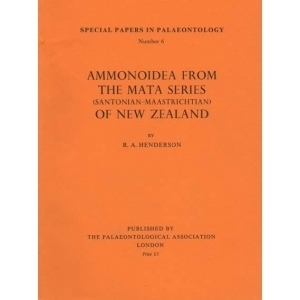
Special Papers in Palaeontology: 6 Ammonites from the Mata Series (Santonian-Maastrichtian) of New Zealand.
1969
by R A Henderson
82 pp., 15 pls.
ABSTRACT. A complete taxonomic revision of ammonites from the Mata Series (Santonian-Maastrichtian) of New Zealand is presented. Two genera and twelve species previously established for New Zealand ammonites of this age are considered to be junior synonyms. The new diplomoceratid genera, Astreptoceras and Masonites, and sixteen new species, Anagaudryceras tennenti, Masoniles biannulatus, Pseudoxybeloceras compressum, P. bicostatum, Kossmaticeras (Natalites) bensoni, Jacobites (Jacobites) flexicostatus, J. (J.) maximus, J. (J.) stevensi, J. (J.) quadratus, J. (J.) marwicki, Maorites angulocostatus, M. multiconstrictus, Gunnarites spathi, G. varicostatus, Neograhamites transitorius, and Eupachydiscus depressus, are proposed. Representatives of Neograhamites, Eupachydiscus, and Anapachydiscus are recorded from New Zealand for the first time. Biostratigraphy of Mata ammonite taxa is reviewed in terms of New Zealand stage divisions. It is thought that two stratigraphically and faunally distinct assemblages can be differentiated, one characteristic of the lower Piripauan Stage and the other characteristic of the upper Piripauan and Haumurian Stages. Correlation with faunas of other countries shows the lower Piripauan assemblage to be of Santonian age while the upper Piripauan and Haumurian assemblage is of Campanian age and may range into the Maastrichtian. Biogeographic relationships of the fauna are discussed in terms of the marked faunal provincialism evident from the global distributions of ammonite taxa for Santonian-Maastrichtian time.